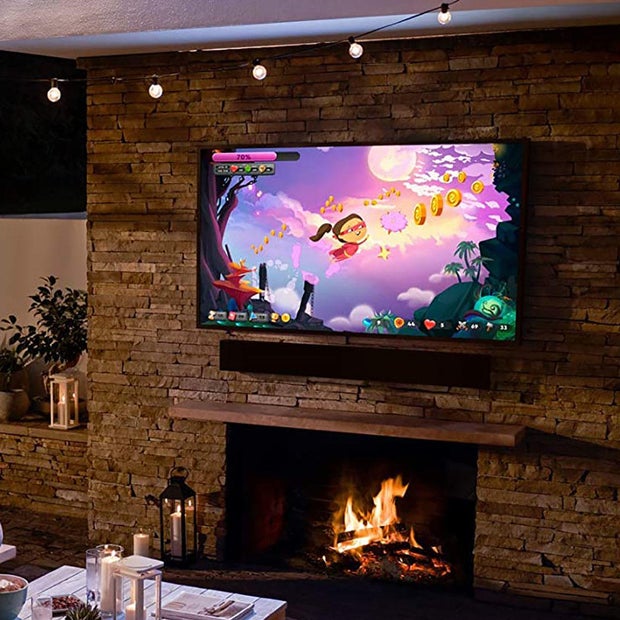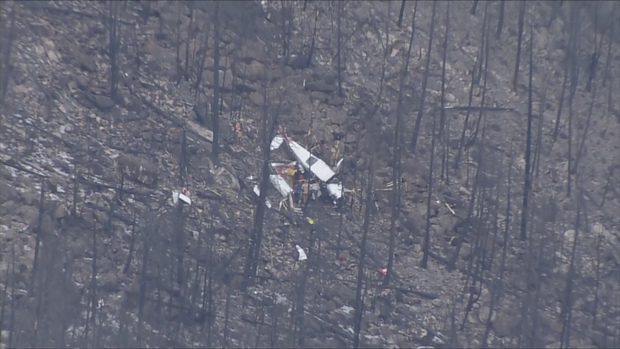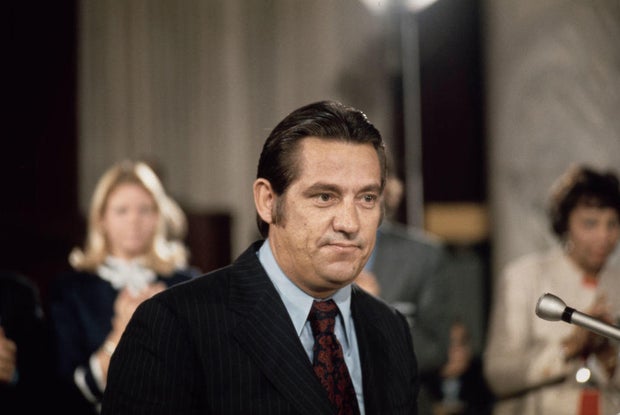CBS News
Get up to $3,500 off the bestselling The Terrace outdoor TV during the Discover Samsung event

Samsung
If you’re a Samsung fan planning outdoor movie nights or football game-watching on your patio this year, consider The Terrace outdoor TV. The bestselling smart TV can be a bit pricey, but right now you can score some major savings on the outdoor model during the Discover Samsung fall sale. You’ll need to act fast, though, as the sale is ending on Sunday.
The 4.7-star-rated TV is a mountable, high-end smart TV with a QLED 4K display and a built-in speaker. Right now you can save up to $3,500 on partial-sun and full-sun models of the customer-loved TV. The must-have outdoor model is marked down, along with a wide range of other popular Samsung OLED and QLED TVs this week during the Discover Samsung sale. Keep reading to learn more about The Terrace TV and explore more deals on the best Samsung televisions.
You can also click the button below to shop the entire Samsung sale.
Samsung’s The Terrace outdoor TV: $3,500 and up
Samsung
The Terrace TV was introduced to Samsung’s line of lifestyle TVs in 2020 as a sibling of the bestselling Frame TV. While the Frame TV, with its customizable wall art, can spruce up your interior space, The Terrace classes up your outdoor space. Plus, it’s legitimately intended for outdoor use, come rain or shine.
The Terrace outdoor TV boasts an anti-reflective coating and is rated IP55 for protection against dust and water. That said, it’s recommended you keep your TV covered and protected when not in use.
The TV offers Wi-Fi and Bluetooth connectivity, works with A.I. assistants like Alexa, and features built-in apps for streamers like Netflix, Amazon Prime and Hulu. Download Samsung’s SmartThings app to control the TV via your phone or device no matter where you are, and to connect the TV to your other compatible smart-home appliances.
For outdoor areas with partial sun:
For outdoor areas in the full sun:
More Discover Samsung smart TV deals to shop now
In conjunction with the Discover Samsung sale, the company has gone all out by offering really impressive deals on virtually all of its popular smart TVs. Right now you can save big on everything from 32-inch models (perfect for a small space or child’s bedroom), to 55- or 65-inch TVs (a great size for an average size living room or bedroom). However, if you want to go bigger, and we mean much bigger, Samsung has slashed the prices of its popular 75-inch and even 85-inch TVs too.
And for extra peace of mind when it comes to your TV investment, consider adding some protection for your purchase through the Samsung Care+ plan, which is available with two or four years of coverage.
Save on Samsung’s 2024 The Frame QLED 4K TV: $900 and up
Samsung
Samsung’s The Frame smart TV is not only one of the most unique TVs you can buy, it’s also the most popular TV amongst our readers. So, if you’ve been wanting to hang one of these ultra-thin TVs on your wall at home, you can grab one as low as $900 during the Discover Samsung fall sale.
Each also offers a unique, anti-glare matte finish with a wide viewing angle. These TVs are able to generate billions of accurate colors that bring whatever you’re watching to life with incredible detail.
Meanwhile, regardless of what size The Frame TV you purchase, it’s only one inch thick and designed to be hung on a wall, just like a picture frame. The TV screen is actually surrounded by your choice of bezels that resemble a traditional picture frame. When you order the TV, you get to choose from a selection of frame colors and styles, so it blends in perfectly with your home’s decor.
Whenever you’re not watching a TV show, movie or sporting event, for example, instead of being turned off and having a large black rectangle hanging on your wall, The Frame TV is able to display your choice of famous works of art. Each piece of art is shown in high resolution, so the images look like real paintings. Even the artist’s paintbrush strokes are typically clearly visible.
The Frame QLED 4K smart TV comes in six sizes — 43 inches ($900), 50 inches ($1,100), 55 inches ($1,300), 65 inches ($1,700), 75 inches ($2,500) and 85 inches ($4,000). When ordering, make sure you select model LS03D, which is the 2024 version.
The 2023 versions (LS03C) are also available (and currently being discounted on Samsung’s website), but these models lack the newest features.
Samsung S90C 55-inch OLED Series 9 (2023): $600 off
Samsung
Typically priced at $1,900, this smart TV can be purchased for $1,300 at Samsung during the Discover Samsung fall sale. TVs with an OLED display are extremely popular because they can offer a contrast-rich and really sharp picture that features vivid and lifelike color, combined with a fast refresh rate and wide viewing angle support. This means you don’t need to be sitting directly in front of the screen to clearly see it. Plus, the artificial intelligence built into many OLED TVs (including this one) analyzes each scene in real time and determines which areas need to be brighter or darkened to ensure consistent and accurate colors.
The Samsung S900C OLED Series 9 is the perfect addition to a living room. For a smaller size space, it is the ideal centerpiece for a home theater setup. Along with seeing accurate and dramatic colors, whatever you’re watching will be enhanced and look more life-like thanks to AI upscaling. And with a maximum brightness of 726 nits, you’ll be able to see a clear picture even if the room is brightly lit. You will also enjoy high-end sound thanks to Dolby Atmos support and Samsung’s object tracking sound feature.
One of the perks of OLED technology is its ability to display bright colors, deep blacks and bright whites. However, this is one of the few TVs that has been Pantone Validated to ensure the colors being displayed are authentic and appear exactly as they were meant to look. Another feature people appreciate that is integrated into this TV is its thin design, so it looks great hanging on a wall, but it also maintains its sleek profile when mounted on its supplied stand.
Samsung 65-Inch S95C OLED: $1,300 off
Samsung
Originally priced at $3,300, Samsung has slashed the price of this TV down to $2,000 during the Discover Samsung fall sale. While QLED and Mini-LED TVs offer an impressively detailed and lifelike picture, someone looking for cutting-edge technology built into their TV should consider an OLED display. One of the features that set this Samsung 65-Inch S95C OLED apart is that this TV is incredibly thin and offers a modern design. If hung on a wall, for example, you’ll barely notice its 0.4-inch thickness. Yet, the 65-inch display size is large enough to provide an average size room with a decently immersive picture.
Thanks to Samsung’s Quantum Dot technology, you’ll see whatever you choose to watch in incredible detail with excellent contrast, brightness and accurate colors. In fact, what’s displayed on the screen is created using 8.3 million self-illuminating pixels. This includes non-native 4K content that the TV upscales to near 4K using its Neural Quantum Processor. To ensure color accuracy, the TV is one of the few to offer Pantone Validation.
Using internal speakers and a subwoofer, this TV capitalizes on Dolby Atmos, Object Tracking Sound+ and when possible, 3D audio that nicely complements the action happening on the screen. And for gaming, you get Samsung’s Game Motion Plus feature that can boost the refresh rate up to 144Hz when playing compatible PC-connected content. The S95C TV falls into the higher end of the mid-price range. The picture and sound quality take full advantage of the higher-end technology integrated into the TV, which makes it well worth the investment.
Samsung 65-Inch Neo 8K QN900C Series 9 (2023): $1,200 off
Samsung
Right now, you can snag this 2023 version of the 65-inch, 8K resolution TV for $3,800 (reduced from $5,000). You’re probably thinking, what could you possibly do with an 8K resolution TV when there’s basically zero native 8K programming you can watch on it. Yes, this QLED television from Samsung is somewhat ahead of its time. But, thanks to integrated AI-upscaling, this TV will take 4K resolution content and do a really nice job upscaling it to near 8K quality. Thus, you’ll be able to see more detail than ever before when watching your favorite shows, movies or sporting events, for example.
Like many other Samsung TV models, the QN900C offers decent quality built in speakers and a subwoofer, so even without an optional soundbar or surround sound system, the audio this TV generates sounds really good. However, since you’re investing in such a high-end TV, we strongly recommend connecting a good quality speaker system to it, so you can really experience the Dolby Atmos sound when watching your favorite content. Oh and you’re in luck. Many of Samsung’s best soundbars and surround sound systems are also on sale. (Keep reading for more details on those sales.)
What sets this 8K resolution TV apart from 4K models is that it offers 7,680 x 4,320 pixel resolution featuring 100% color volume thanks to Samsung’s Quantum Dot and Neo Quantum HDR 8K+ technology. And no matter where someone is sitting within the room, they’ll see a clear picture, even from an angle. If you consider yourself an early adopter when it comes to the latest technology and you have the budget to invest in an 8K TV, the 2023 version of the Samsung 65 inch Neo 8K QN900C Series 9 offers a viewing experience that very few competitors can rival.
CBS News
2 killed in U.S. Civil Air Patrol plane crash near Palisade Mountain in Northern Colorado

Two people were killed and a third was injured when a U.S. Civil Air Patrol plane crashed in Colorado’s Front Range Saturday morning.
The small passenger plane with three people aboard crashed near Storm Mountain and Palisade Mountain west of Loveland around 11:15 a.m., according to the Larimer County Sheriff’s Office. The plane belonged to the Civil Air Patrol, the civilian auxiliary wing of the U.S. Air Force, and was on a routine aerial photography training mission when it went down, officials said.
Pilot Susan Wolber and aerial photographer Jay Rhoten were identified by CAP as those killed and co-pilot Randall Settergren was identified as the person injured. Settergren was airlifted to an area hospital by a National Guard helicopter, where he is undergoing medical care.
CBS
“The volunteers of Civil Air Patrol are a valuable part of the Department of Military and Veterans Affairs, and the lifesaving work they do on a daily basis directly contributes to the public safety of Coloradans throughout the state,” Maj. Gen. Laura Clellan, adjutant general of the Colorado Department of Military and Veterans Affairs, said in a statement Saturday.
“We are devastated to hear of the loss of Susan Wolber and Jay Rhoten, and the injury of Randall Settergren, during a training mission in Larimer County. Our thoughts and deepest condolences are with the families of those involved in the crash,” Clellan continued. “I would also like to thank all of the first responders who assisted with rescue efforts.”
Palisade Mountain is in Larimer County, about 20 miles west of Loveland and about 65 miles northwest of Denver. The area is part of the burn scar of the Alexander Mountain Fire, which burned almost 10,000 acres in over two weeks this past summer.
The crash happened about 200 feet below the summit of Palisade Mountain in an area that includes tall trees and steep hills as part of the mountain range. Rescue crews were heard on radio traffic working to find a landing zone for rescue helicopters. No structures were impacted by the crash.
The plane crashed in “very rugged” and “extensive and rocky terrain,” Ali Adams, a Larimer County Sheriff’s Office spokeswoman, said at a news conference. First responders had to hike out to the site and the sole survivor was “severely injured” when responders finally got to them.
Rescue efforts were ongoing at 3:15 p.m., according to Adams, and recovery efforts for the two deceased people’s bodies could take several days.
Several agencies responded, including the Loveland Fire Rescue Authority, Thompson Valley EMS and the National Guard.
The Larimer County Sheriff’s Office is the lead agency investigating the crash and the Federal Aviation Administration and National Transportation Safety Board will assist, according to Adams. The NTSB said it too was investigating the crash and identified the plane as a Cessna 182.
“This is one of those incidents that is really low frequency; it doesn’t happen really often, but unfortunately, our first responders have had more than their fair share of responses,” Adams said.
George Solheim lives in the area of the crash. He described conditions as “extremely windy” on Saturday and heard the plane just prior to the crash. He says he could hear “loud ‘throttle up/down’ immediately prior to sudden silence at (the) time of (the) crash. Couldn’t hear sounds of impact from here.”
Colorado Gov. Jared Polis extended his sympathy to the families of the victims in a statement Saturday evening:
“I’m saddened to hear of the loss of two dedicated Civil Air Patrol members, Pilot Susan Wolber and aerial photographer Jay Rhoten, who lost their lives in today’s crash and my thoughts are with their families, friends and colleagues. These individuals, along with survivor co-pilot Randall Settergren, who was injured, served the Civil Air Patrol as volunteers who wanted to help make Colorado a better, safer place for all. The State of Colorado is grateful for their commitment to service and it will not be forgotten. I also want to thank the first responders who assisted with the rescue and recovery efforts.”
CBS News
Fred Harris, former Democratic U.S. senator and presidential candidate, dies at 94

Fred Harris, a former U.S. senator from Oklahoma, presidential hopeful and populist who championed Democratic Party reforms in the turbulent 1960s, died Saturday. He was 94.
Harris’ wife, Margaret Elliston, confirmed his death to The Associated Press. He had lived in New Mexico since 1976.
“Fred Harris passed peacefully early this morning of natural causes. He was 94. He was a wonderful and beloved man. His memory is a blessing,” Elliston said in a text message.
Bettmann Archive/Getty Images
Harris served eight years in the Senate, first winning in 1964 to fill a vacancy, and made unsuccessful bid for the presidency in 1976.
“I am deeply saddened to learn of the passing of my longtime friend Fred Harris today,” Democratic New Mexico Gov. Michelle Lujan Grisham wrote in a post to social media. “Harris was a towering presence in politics and in academia, and his work over many decades improved New Mexico and the nation. He will be greatly missed.”
Democratic Sen. Martin Heinrich of New Mexico said in a statement that “New Mexico and our nation have lost a giant,” describing him as a “tireless champion of civil rights, tribal sovereignty and working families.”
It fell to Harris, as chairman of the Democratic National Committee in 1969 and 1970, to help heal the party’s wounds from the tumultuous national convention in 1968 when protesters and police clashed in Chicago.
He ushered in rule changes that led to more women and minorities as convention delegates and in leadership positions.
“I think it’s worked wonderfully,” Harris recalled in 2004, when he was a delegate to the Democratic National Convention in Boston. “It’s made the selection much more legitimate and democratic.”
“The Democratic Party was not democratic, and many of the delegations were pretty much boss-controlled or -dominated. And in the South, there was terrible discrimination against African Americans,” he said.
Harris ran unsuccessfully for the Democratic presidential nomination in 1976, quitting after poor showings in early contests, including a fourth-place win in New Hampshire. The more moderate Jimmy Carter went on to win the presidency.
Harris moved to New Mexico that year and became a political science professor at the University of New Mexico. He wrote and edited more than a dozen books, mostly on politics and Congress. In 1999 he broadened his writings with a mystery set in Depression-era Oklahoma.
Throughout his political career, Harris was a leading liberal voice for civil rights and anti-poverty programs to help minorities and the disadvantaged. Along with his first wife, LaDonna, a Comanche, he also was active in Native American issues.
“I’ve always called myself a populist or progressive,” Harris said in a 1998 interview. “I’m against concentrated power. I don’t like the power of money in politics. I think we ought to have programs for the middle class and working class.”
“Today ‘populism’ is often a dirty word because of how certain leaders wield power,” Heinrich said in his statement Saturday. “But Fred represented a different brand of populism — one that was never mean or exclusionary. Instead, Fred focused his work and attention on regular people who are often overlooked by the political class.”
Harris was a member of the National Advisory Commission on Civil Disorders, the so-called Kerner Commission, appointed by then-President Lyndon Johnson to investigate the urban riots of the late 1960s.
The commission’s groundbreaking report in 1968 declared, “our nation is moving toward two societies, one black, one white — separate and unequal.”
Thirty years later, Harris co-wrote a report that concluded the commission’s “prophecy has come to pass.”
“The rich are getting richer, the poor are getting poorer and minorities are suffering disproportionately,” said the report by Harris and Lynn A. Curtis, president of the Milton S. Eisenhower Foundation, which continued the work of the commission.
Norman Ornstein of the American Enterprise Institute said Harris rose to prominence in Congress as a “fiery populist.”
“That resonates with people…the notion of the average person against the elite,” Ornstein said. “Fred Harris had a real ability to articulate those concerns, particularly of the downtrodden.”
In 1968, Harris served as co-chairman of the presidential campaign of then-Vice President Hubert Humphrey. He and others pressed Humphrey to use the convention to break with Johnson on the Vietnam War. But Humphrey waited to do so until late in the campaign, and narrowly lost to Republican Richard Nixon.
“That was the worst year of my life, ’68. We had Dr. Martin Luther King killed. We had my Senate seatmate Robert Kennedy killed and then we had this terrible convention,” Harris said in 1996.
“I left the convention — because of the terrible disorders and the way they had been handled and the failure to adopt a new peace platform — really downhearted.”
After assuming the Democratic Party leadership post, Harris appointed commissions that recommended reforms in the procedures for selecting delegates and presidential nominees. While lauding the greater openness and diversity, he said there had been a side effect: “It’s much to the good. But the one result of it is that conventions today are ratifying conventions. So it’s hard to make them interesting.”
“My own thought is they ought to be shortened to a couple of days. But they are still worth having, I think, as a way to adopt a platform, as a kind of pep rally, as a way to get people together in a kind of coalition-building,” he said.
Harris was born Nov. 13, 1930, in a two-room farmhouse near Walters, in southwestern Oklahoma, about 15 miles from the Texas line. The home had no electricity, indoor toilet or running water.
At age 5 he was working on the farm and received 10 cents a day to drive a horse in circles to supply power for a hay bailer.
He worked part-time as a janitor and printer’s assistant to help for his education at University of Oklahoma. He earned a bachelor’s degree in 1952, majoring in political science and history. He received a law degree from the University of Oklahoma in 1954, and then moved to Lawton to practice.
In 1956, he won election to the Oklahoma state Senate and served for eight years. In 1964, he launched his career in national politics in the race to replace Sen. Robert S. Kerr, who died in January 1963.
Harris won the Democratic nomination in a runoff election against J. Howard Edmondson, who left the governorship to fill Kerr’s vacancy until the next election. In the general election, Harris defeated an Oklahoma sports legend — Charles “Bud” Wilkinson, who had coached OU football for 17 years.
Harris won a six-year term in 1966 but left the Senate in 1972 when there were doubts that he, as a left-leaning Democrat, could win reelection.
Harris married his high school sweetheart, LaDonna Vita Crawford, in 1949, and had three children, Kathryn, Byron and Laura. After the couple divorced, Harris married Margaret Elliston in 1983. A complete list of survivors was not immediately available Saturday.
CBS News
Compromise deal reached at COP29 climate talks for $300 billion a year to poor nations

Countries agreed on a deal to inject at least $300 billion annually in humanity’s fight against climate change, aimed at helping poor nations cope with the ravages of global warming at tense United Nations climate talks in the city where industry first tapped oil.
The $300 billion will go to developing countries who need the cash to wean themselves off the coal, oil and gas that causes the globe to overheat, adapt to future warming and pay for the damage caused by climate change’s extreme weather. It’s not near the full amount of $1.3 trillion that developing countries were asking for, but it’s three times the $100 billion a year deal from 2009 that is expiring. Delegations said this deal is headed in the right direction, with hopes that more money flows in the future.
“Everybody is committed to having an agreement,” Fiji delegation chief Biman Prasad said as the deal was being finalized. “They are not necessarily happy about everything, but the bottom line is everybody wants a good agreement.”
It’s also a critical step toward helping countries on the receiving end create more ambitious targets to limit or cut emissions of heat-trapping gases that are due early next year. It’s part of the plan to keep cutting pollution with new targets every five years, which the world agreed to at the U.N. talks in Paris in 2015.
The Paris agreement set the system of regular ratcheting up climate fighting ambition as away to keep warming under 1.5 degrees Celsius above pre-industrial levels. The world is already at 1.3 degrees Celsius and carbon emissions keep rising.
Countries also anticipate that this deal will send signals that help drive funding from other sources, like multilateral development banks and private sources. That was always part of the discussion at these talks — rich countries didn’t think it was realistic to only rely on public funding sources — but poor countries worried that if the money came in loans instead of grants, it would send them sliding further backward into debt that they already struggle with.
“The $300 billion goal is not enough, but is an important down payment toward a safer, more equitable future,” said World Resources Institute President Ani Dasgupta. “This deal gets us off the starting block. Now the race is on to raise much more climate finance from a range of public and private sources, putting the whole financial system to work behind developing countries’ transitions.”
It’s more than the $250 billion that was on the table in the first draft of the text, which outraged many countries and led to a period of frustration and stalling over the final hours of the summit. After an initial proposal of $250 billion a year was soundly rejected, the Azerbaijan presidency brewed up a new rough draft of $300 billion, that was never formally presented, but also dismissed roundly by African nations and small island states, according to messages relayed from inside.
The several different texts adopted early Sunday morning included a vague but not specific reference to last year’s Global Stocktake approved in Dubai. Last year there was a battle about first-of-its-kind language on getting rid of the oil, coal and natural gas, but instead it called for a transition away from fossil fuels. The latest talks only referred to the Dubai deal, but did not explicitly repeat the call for a transition away from fossil fuels.
Countries also agreed on the adoption of Article 6, creating markets to trade carbon pollution rights, an idea that was set up as part of the 2015 Paris Agreement to help nations work together to reduce climate-causing pollution. Part of that was a system of carbon credits, allowing nations to put planet-warming gasses in the air if they offset emissions elsewhere. Supporters said a U.N.-backed market could generate up to an additional $250 billion a year in climate financial aid.
Despite its approval, carbon markets remain a contentious plan because many experts say the new rules adopted don’t prevent misuse, don’t work and give big polluters an excuse to continue spewing emissions.
“What they’ve done essentially is undermine the mandate to try to reach 1.5,” said Tamara Gilbertson, climate justice program coordinator with the Indigenous Environmental Network. Greenpeace’s An Lambrechts, called it a “climate scam” with many loopholes.
With this deal wrapped up as crews dismantle the temporary venue, many have eyes on next year’s climate talks in Belem, Brazil.









